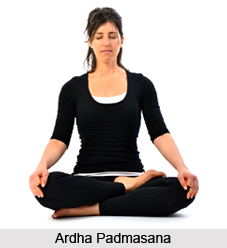 Ardha Padmasana is a cultural asana derived from the Padmasana, one of Yoga`s most famous poses. It is intended as a rudimentary sequence for novices who may find the Padmasana prohibitively difficult.
Ardha Padmasana is a cultural asana derived from the Padmasana, one of Yoga`s most famous poses. It is intended as a rudimentary sequence for novices who may find the Padmasana prohibitively difficult.
Meaning of Ardha Padmasana
Ardha means half in Sanskrit, and the asana`s name essentially menas the half padmasana or the half lotus pose. Novices practice Ardha Padmasana for a few days before attempting to sit in Padmasana
Practice of Ardha Padmasana
1. Sit in a simple sitting position.
2. Sit stretching out both legs, hands by the side of the body, palms on the ground, fingers together pointing forward.
3. Hold the right foot with the left hand and the right ankle with the right hand and place the right leg on the left thigh.
4. In the same way, place the left leg under the right thigh.
5. Sit erect, as in Padmasana, keep the right hand on the folded right knee with the fingers in a position like Chin Mudra or Jnana Mudra.
6. Gaze should be pointed towards the nose or in front.
7. Make sure about breathing normally
8. It is advisable to sit in this position for a little longer time before practicing Padmasana and other asanas that are based on Padmasana.
9. While coming back, loosen the hands and stretch out the left leg first.
10. Then stretch out right leg and return to the original position.
Effects of Ardha Padmasana
* It relaxes the body and mind and prepares one for Padmasana and other asanas that are based on Padmasana.
* It also improves digestion and helps in concentration and relaxation of mind.
* It`s very suitable for meditation and an be used until one learns to do Padmasana with ease.
This article is a stub. You can enrich by adding more information to it. Send your Write Up to content@indianetzone.com




















